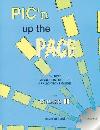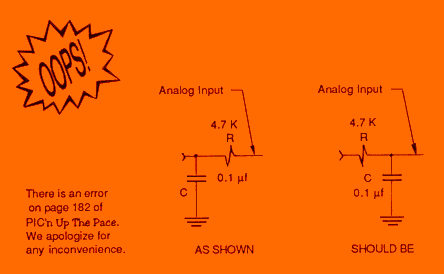


Learn about PIC microcontrollers from our PIC books Easy PIC'n, PIC'n
Up The Pace, PIC'n Techniques and Serial PIC'n. The hands on, step by step
presentation leads the reader through a series of experiments using assembly
language code to exercise the Microchip PIC microcontroller.
 "EASY PIC'n, A
Beginner's Guide to Using PIC Microcontrollers"
"EASY PIC'n, A
Beginner's Guide to Using PIC Microcontrollers"
"Easy PIC'n" © is intended to ease the beginner toward understanding
and application of the PIC line of
microcontrollers from Microchip Technology, Inc. The book may be used
in the application of microcontrollers. Examples of
assembly language programs range from a simple one to turn on LED's
to more complex ones for timing and for
event-counting. Writing programs is covered in-depth and the use of
flow charts, as an aid to visualizing what a program does,
is emphasized. The approach is hands-on with many examples, all of
which may be demonstrated using a very simple demo
board (a project) in the beginning of the book by David Benson (8-1/2
x 11", 150 pages).
 Table
of Contents
Table
of Contents
 "PIC'n Up The Pace, PIC
Microcontroller Applications Guide"
"PIC'n Up The Pace, PIC
Microcontroller Applications Guide"
"PIC'n Up The Pace" © is an intermediate level applications guide
covering Microchip Technology's PIC
Microcontrollers (now renamed PICmicro). Serial communication as a
means of transferring data between PIC's and
peripheral chips and also between two or more PIC's is described. Use
of the 93C46 serial EEPROM is detailed as an
example. Since we live in an analog world, A/D and D/A are discussed
with several methods illustrated for each. Conditioning
signals from sensors with an analog voltage output is described. Interfacing
PIC controlled systems with humans requires some
math, binary to decimal conversion and vice versa, alphanumeric LCD
intefacing and scanning keypads. Single wire serial
communication with a PIC-controlled LCD module which can be built by
the reader is included. A digital thermometer
example projects brings these topics together as an example. Finally,
PIC16C84/PIC16F84 data EEPROM memory,
program memory paging and locating tables in program memory are discussed.
"PIC'n Up The Pace" gives the reader the tools to design and build intermediate
microcontroller-based instrumentation and
systems by David Benson, 275 pages, 8-1/2 x 11 format)
 Table
of Contents
Table
of Contents

 "PIC'n Techniques, PIC
Microcontroller Applications Guide"
"PIC'n Techniques, PIC
Microcontroller Applications Guide"
"PIC'n Techniques"is an intermediate level applications guide covering
Microchip
Technology's PIC microcontrollers. The book describes the unique features
of the 8-pin
microcontrollers. The use of timer 1, timer 2 and the capture/compare/PWM
(CCP) module is
detailed, followed by timing, counting and pulse width modulation (PWM)
experiments. These
experiments include producing a single time interval output, free running
pulse output, event
counting, time measurement, frequency measurement and PWM. Some of
these techniques are
illustrated further by experiments which show how to design and build
simple digital pulse and
frequency generators and time interval and frequency measurement instruments.
The book also
explains how to establish serial communication between a PIC chip and
a PC via a RS-232
conversion circuit and a terminal program. These techniques are used
in a digital voltmeter/data
logger experiment for uploading data to a PC for display plus graphing
using a spreadsheet
program. "PIC'n Techniques" illustrates techniques used in designing
and building
intermediate level microcontroller-based instrumentation and systems.
 Table
of Contents
Table
of Contents
 "Serial PIC'n, PIC
Microcontroller Serial Communications"
"Serial PIC'n, PIC
Microcontroller Serial Communications"
"Serial PIC'n" © is a comprehensive book which details various
methods for implementing serial communications
between a Microchip PIC microcontroller and an external device. Asynchronous
serial communications is covered both by
using an on-chip USART and by bit-bang methods. The RS-232 standard
is explained. A discussion of synchronous serial
communications includes the I2C (Philips Semiconductors), SPI (Motorola)
and Microwire (National Semiconductor)
protocols. The Dallas Semiconductor 1-Wire bus is described. Many code
examples are included as modules which will
provide the basis for the reader's own PIC microcontroller applications.
By Roger Stevens (8-1/2 x 11", 520 pages).
 Table
of Contents
Table
of Contents